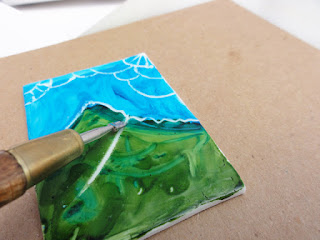I am going to show you how I usually do with things that could be potentially be a real pain when manufacturing for myself.
As in yarn dye lots, there are always differences and then there is the added changes in products for using in polymer clay being in the safety and availability ever changing field!
So I usually go with the flow on the changes coming forward nowadays and hack the color. Or as close as I can get!
OK, the skull in the middle is the older red/ruby, the one on the right is the new red/ruby, and the one on the left is the red/ruby I made from the new red and the Yellow/Amber translucent color.
 They are all slightly different: the one on the right, the new one, is very Carmine-y and bluer, It is lovely in its own way. I thought this may be a better mixing red, it is but I will get to that later. Notice the darker skull at the bottom right, that is the purple I got from 3 part Ruby and 1 part Sapphire, it is a gorgeous purple and rich, if you added another part of the new ruby, you will a bight intense purple which most people know as violet.
They are all slightly different: the one on the right, the new one, is very Carmine-y and bluer, It is lovely in its own way. I thought this may be a better mixing red, it is but I will get to that later. Notice the darker skull at the bottom right, that is the purple I got from 3 part Ruby and 1 part Sapphire, it is a gorgeous purple and rich, if you added another part of the new ruby, you will a bight intense purple which most people know as violet.
One advantage of this new red is pleasing purples and oranges from it's mixing abilities.
The one in the middle is the oldest red/ruby color package that I had, it is definitely Warmer in color.
The one on the right is the color I mixed up the first time: it is 3 parts Ruby and 1/2 part Amber, it is not warn enough to match or get close to the middle colored skull. But is it good and you can barely see the difference, so it probably needs maybe 1/4 part more. I can tell that from these sheets below.
The red on the left is the mixed color I made after using the new red 3 parts and the amber 1 whole part now to see where to go next with the color. I believe that the paragraph above is the answer with 3/4 part amber to 3 parts Ruby.
This is the purple I mixed up with the new Ruby Color as per my last shipment.
 The purple on the right is the one I mixed up from the formula 3 parts ruby and 1 part sapphire. The one on the left is the purple that we have available to us in the Cernit palette, Now these work fabulous together and can be the other color you need in your purple shades that you use.
The purple on the right is the one I mixed up from the formula 3 parts ruby and 1 part sapphire. The one on the left is the purple that we have available to us in the Cernit palette, Now these work fabulous together and can be the other color you need in your purple shades that you use. The photo here on your right with one piece of purple clay I am holding. Isn't it gorgeous? It is also yummy hit you in the face face color, that I love so much. But when you use it with light behind it, oh my goodness. This is wonderful!
The photo here on your right with one piece of purple clay I am holding. Isn't it gorgeous? It is also yummy hit you in the face face color, that I love so much. But when you use it with light behind it, oh my goodness. This is wonderful!Here is the whole palette of all the colors mixed and otherwise and this a great bunch of colors that shout come play with me!
All of these Cernit translucent sheets are rolled out on the thinnest setting in my machine. My setting go from the thickest being 0 and the thinnest being a 9.
I am quite pleased at how Cernit does this so very well.
Just roll down one thickness at a time to get sheets like this! Oh and do not try when the clay has just been made, it is too smooshy for that!
Need some incredible translucent clay to play with?
www.clayfactory.net/
http://clayfactory.net/cernit/cernit-polymer-clay-translucent-colors.html
























